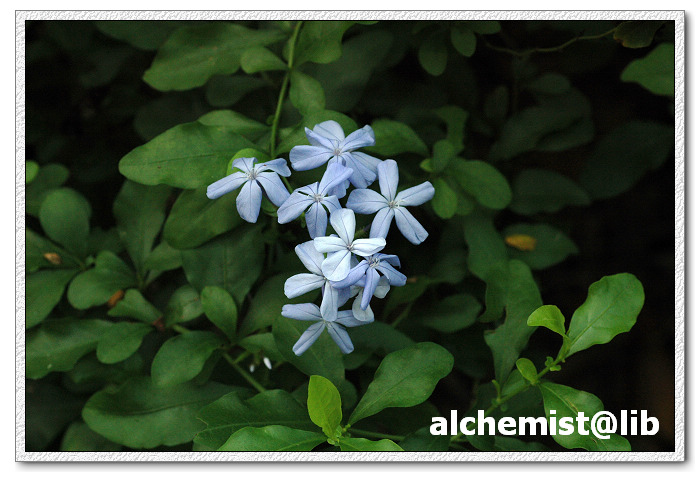- Scientific Name: Plumbago auriculata Lam.
- Ref: Encycl. 2:270. 1786
- Synonyms: Plumbagidium auriculatum (Lam.) Spach; Plumbago capensis Thunb.
- English Common Name: blue plumbago, Cape plumbago, Cape leadwort
- Chinese Common Name: 蓝雪花 lánxuě∙huā, 蓝花丹 lánhuā∙dān
- Japanese Common Name: ルリマツリ [瑠璃茉莉] rurimatsuri
- Family: Plumbaginaceae
- Genus: Plumbago
- Distribution: Hummocks, thickets, disturbed sites in dry soil; 0-50 m; native to S Africa.
- Photo: 06/21/2009, South China Botanical Garden, Guangdong
Plants evergreen shrubs. Stems erect, trailing, or climbing, diffusely branched, to 3+ m, glabrous or pubescent on youngest shoots. Leaves usually sessile, sometimes short-petiolate; blade elliptic, oblanceolate, or spatulate, (1-)2.5-9 × 0.5-2.5 cm, base usually long-attenuate, sometimes auriculate, apex acute or obtuse, mucronate. Inflorescences 2.5-3(-5) cm, rachises short-pilose (hairs ca. 0.1 mm), eglandular; floral bracts lanceolate, 3-9 × 1-2 mm. Flowers 3-stylous; calyx 10-13 mm, tube usually short-pilose and with stalked, capitate, glandlike protuberances ca. 1 mm along distal 1/ 3/ 4 of ribs; corolla pale blue, 37-53 mm, tube 28-40 mm (more than 2 times length of calyx), lobes 10-16 × 6-15 mm; stamens included or exserted. Capsules 8 mm. Seeds brown, 7 mm. 2n = 14 + 0-1B. (FNA Vol. 5)
